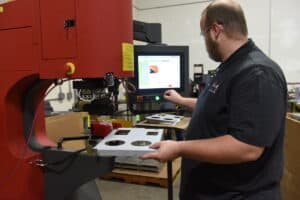The metal manufacturing process your part or component goes through is going to depend on the specifics of your need. We’re a multifaceted metal manufacturer, meaning we have multiple ways to make a part. We have comprehensive equipment, and we have highly-skilled employees who aren’t just metal fabricators – they’re problem solvers.
Our capabilities are multi-level and complex. We offer four primary services that are all performed in-house:
 A lot of the parts we make for our customers start out as a prototype. Whether they worked with our design and engineering department or had something drawn up on their end, we’re going to review the design for metal fabrication best practices and build out the prototype.
A lot of the parts we make for our customers start out as a prototype. Whether they worked with our design and engineering department or had something drawn up on their end, we’re going to review the design for metal fabrication best practices and build out the prototype.
- Design & Engineering
- Tool & Die Build
- Short Run and Long Run Progressive Stamping
- Sheet Metal Fabrication
PROTOTYPE
 A lot of the parts we make for our customers start out as a prototype. Whether they worked with our design and engineering department or had something drawn up on their end, we’re going to review the design for metal fabrication best practices and build out the prototype.
A lot of the parts we make for our customers start out as a prototype. Whether they worked with our design and engineering department or had something drawn up on their end, we’re going to review the design for metal fabrication best practices and build out the prototype.

